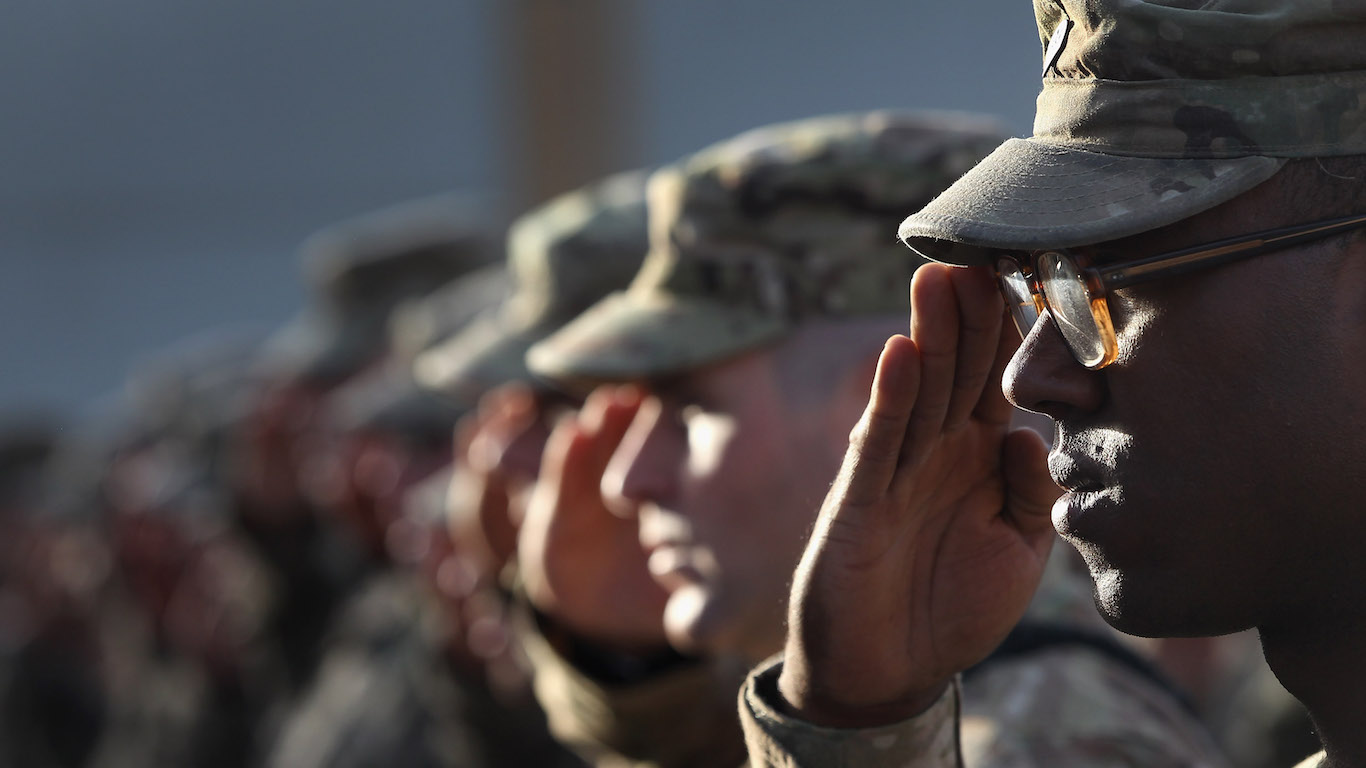
Since the United States began its ongoing global war on terror following the Sept. 11, 2001, terrorist attacks, it has been involved militarily in countries with conflicts that have displaced tens of millions of people.
Along with metrics about how many civilians have been killed or injured in the global war on terror, wartime displacement is another important measure. The war sparked by the Russian invasion of Ukraine, for example, has displaced nearly 8 million Ukranians who have fled to other European countries and millions more who have sought refuge internally from their shattered homes and neighborhoods. (Here are 29 countries currently at war.)
According to one academic study, at least 37 million people have had their lives completely upended in eight countries the U.S. has engaged in militarily since the 9/11 attacks.
To determine the U.S. wars that displaced the most people after 9/11, 24/7 Wall St. reviewed a study from the Watson Institute of Brown University titled “Costs of War, Creating Refugees: Displacement Caused by the United States’ Post-9/11 Wars.” The study examined the number of refugees, asylum seekers, and those internally displaced by wars “in which U.S. forces have been most significantly involved.” Countries are ordered by the number of refugees and asylum seekers. We included current population data from the World Bank.
Among the eight countries where the U.S. has been most significantly involved since 9/11, two engagements ended last year with the withdrawal of troops from Afghanistan, and four are ongoing U.S. military engagements: in Iraq, Syria, Somalia, and Yemen. (Also see, the U.S. government is involved in secret wars in 15 countries.)
The definition of war here is broadly defined. For example, the U.S. fought a war in the Philippines from 1899 to 1902, but from 2002 to 2007 it deployed hundreds of non-combat and support advisors in Manila’s fight against Islamist extremists in the south. Since the start of the global war on terror, internal conflict has forced more than 1.7 million Filipinos from their homes, most of them seeking refuge in other parts of the country. The U.S. involvement in this war is far different from its involvement in Iraq, for example.
Here are the U.S. wars that have displaced the most people since the 9/11 terrorist attacks.

8. Libya
> Start of conflict: 2011
> Refugees & asylum seekers: 169,027
> Internally displaced people: 1,037,733
> Total displaced: 1,206,760
> Total displaced as percent of pre-war population: 19%
> Returnees: 1,438,691
> Population (2021): 6,735,280
Over 1.2 million, about 19% of the Libyan population, have been displaced internally or become refugees and asylum seekers as a result of the two civil wars in the country beginning in the
2011 uprising against the country’s longtime dictator Muammar Gaddafi.
The U.S. participated in a broader Western military intervention in 2011 during the country’s first civil war against Gaddafi, who was killed by rebels on Oct. 10, 2011, following a series of NATO air strikes against forces loyal to the flamboyant dictator near the city of Sirte. From 2015 to 2019, the U.S. was directly involved militarily in this unstable and conflict-ravaged North African country during its second civil war. The U.S. withdrew troops from the country in April 2019 despite ongoing internal conflicts that include the presence of militarized Islamic extremists.
[in-text-ad]

7. Philippines
> Start of conflict: 2002
> Refugees & asylum seekers: 9,481
> Internally displaced people: 1,715,376
> Total displaced: 1,724,857
> Total displaced as percent of pre-war population: 2%
> Returnees: 2,036,258
> Population (2021): 113,880,330
Though they account for a relatively small 2% of the Philippines population, over 1.7 million have been displaced in the country as a result of different separatists and rebel groups fighting against government forces.
From 2002 to 2007, the United States committed hundreds of troops to support the Philippines government’s fight against Islamic separatists in the restive southern region of the country. Part of America’s Operation Enduring Freedom, which ended in 2014, the American non-combat support operations focused on fighting the Philippines Islamist Abu Sayyaf militant group, which had ties to al-Qaeda leader Osama bin Laden. The group has been organizing bombings, kidnappings, and assassinations of civilians. The Philippines continues to fight Abu Sayyaf, but the group’s influence has declined in recent years. A group leader and 20 militants surrendered in January.
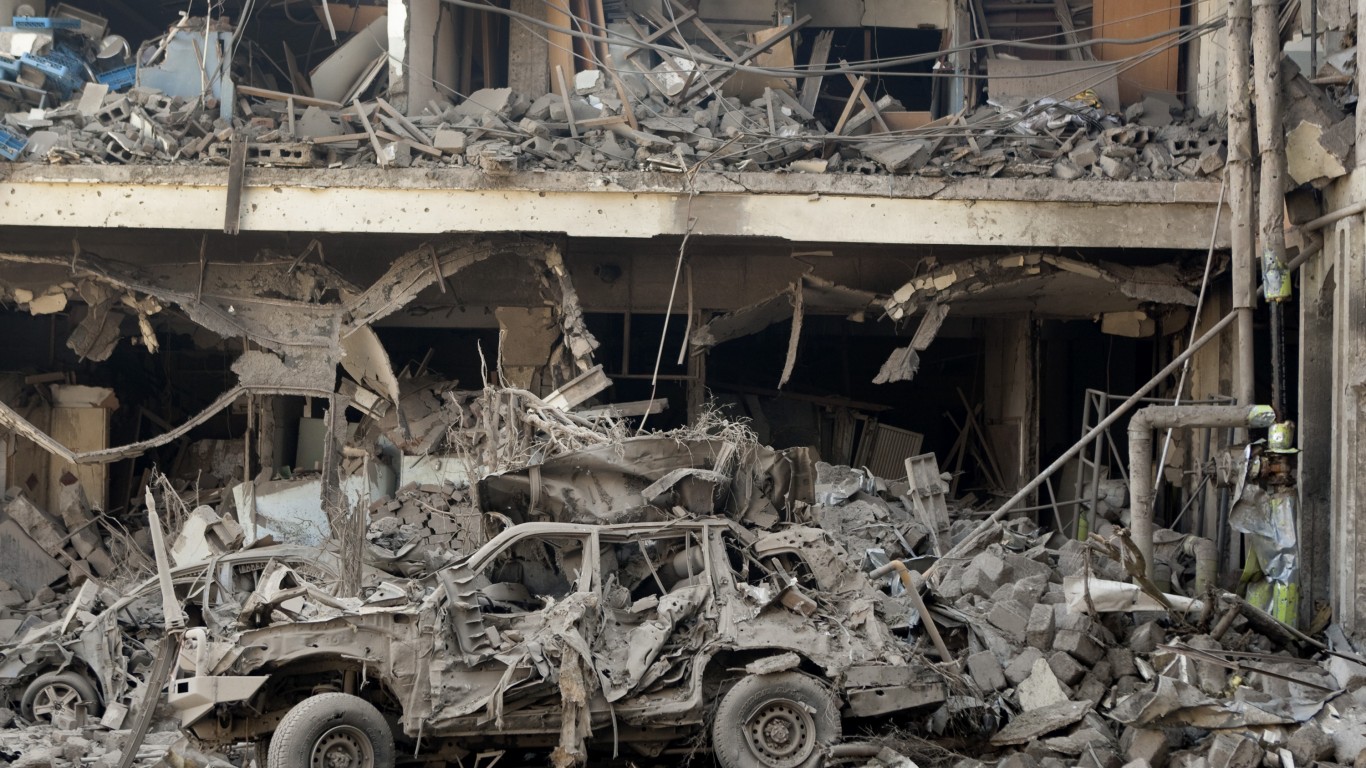
6. Pakistan
> Start of conflict: 2001
> Refugees & asylum seekers: 360,643
> Internally displaced people: 3,363,753
> Total displaced: 3,724,396
> Total displaced as percent of pre-war population: 3%
> Returnees: 4,153,046
> Population (2021): 231,402,120
Pakistan’s proximity to Afghanistan has always made it an integral focus of the global U.S. war on terror generally and Operation Enduring Freedom specifically – even if the U.S. was never technically “at war” in Pakistan. Still, with al-Qaeda forces fleeing to Pakistan and the U.S. engaging in drone and air strikes, nearly 3.4 million people have been displaced, at least half living near the Afghani border and other parts of northwest Pakistan.
Terrorist mastermind Osama bin Laden was killed by U.S. special forces in the northwestern city of Abbottabad in 2011, underscoring how much Pakistan had been used as a haven for Islamist extremists. Following the pullout of troops from Afghanistan in August 2021, officially ending the U.S. war there after two decades, relations between the U.S. and Pakistan continue to be framed by the ongoing situation in Taliban-led Afghanistan.
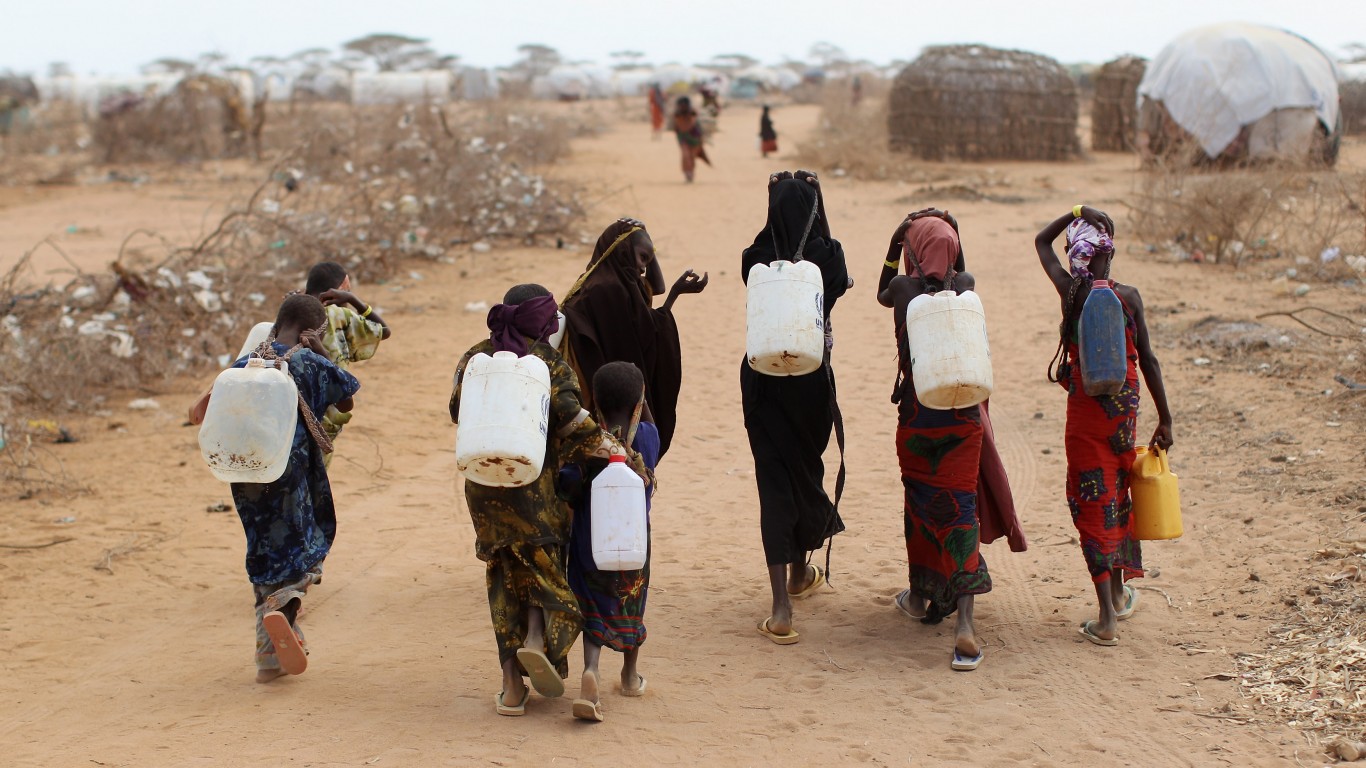
5. Somalia
> Start of conflict: 2002
> Refugees & asylum seekers: 813,215
> Internally displaced people: 3,383,610
> Total displaced: 4,196,825
> Total displaced as percent of pre-war population: 46%
> Returnees: 480,737
> Population (2021): 17,065,580
Ridley Scott’s 2001 war film “Black Hawk Down” depicted the 1993 Battle of Mogadishu, in which dozens of U.S. special operations troops were killed or injured by Islamist extremists. Hundreds of Somalis, including civilians, were also killed in the carnage, while dead U.S. soldiers were dragged through the streets. The nearly 4.2 million people who have been displaced in the country as a result account for a whopping 46% of the pre-war population.
Over time, the American public’s attention to Somalia’s ongoing civil war and the constant threat from al-Shabaab terrorists has waned. Since the 9/11 terrorist attacks, the U.S. mission in Somalia has evolved to focus on Islamist militant activities and the U.S.’s military engagement there is ongoing and includes drone strikes and the deployment of military advisors to local and regional African partners.
[in-text-ad-2]

4. Yemen
> Start of conflict: 2002
> Refugees & asylum seekers: 71,067
> Internally displaced people: 4,283,701
> Total displaced: 4,354,768
> Total displaced as percent of pre-war population: 24%
> Returnees: 1,689,283
> Population (2021): 32,981,640
Yemen has been a focus of U.S. counterterrorism operations since the October 2000 bombing of the USS Cole, one of al-Qaeda’s most significant attacks until the events of Sept. 11, 2001. This focus intensified after 2014, when Iranian-backed Houthi rebels began fighting a Saudi Arabian-led coalition that has purchased U.S. weapons used in the still ongoing Yemen civil war. The civil war has displaced about 4.4 million people, or about 24% of Yemen’s pre-war population.
In a letter to Congress last year, President Joe Biden said a “small number” of U.S. military personnel are deployed in Yemen and that the U.S. continues to “work closely” with the Yemeni government in its fight against al-Qaeda in the Arabian Peninsula and Islamic State militants.
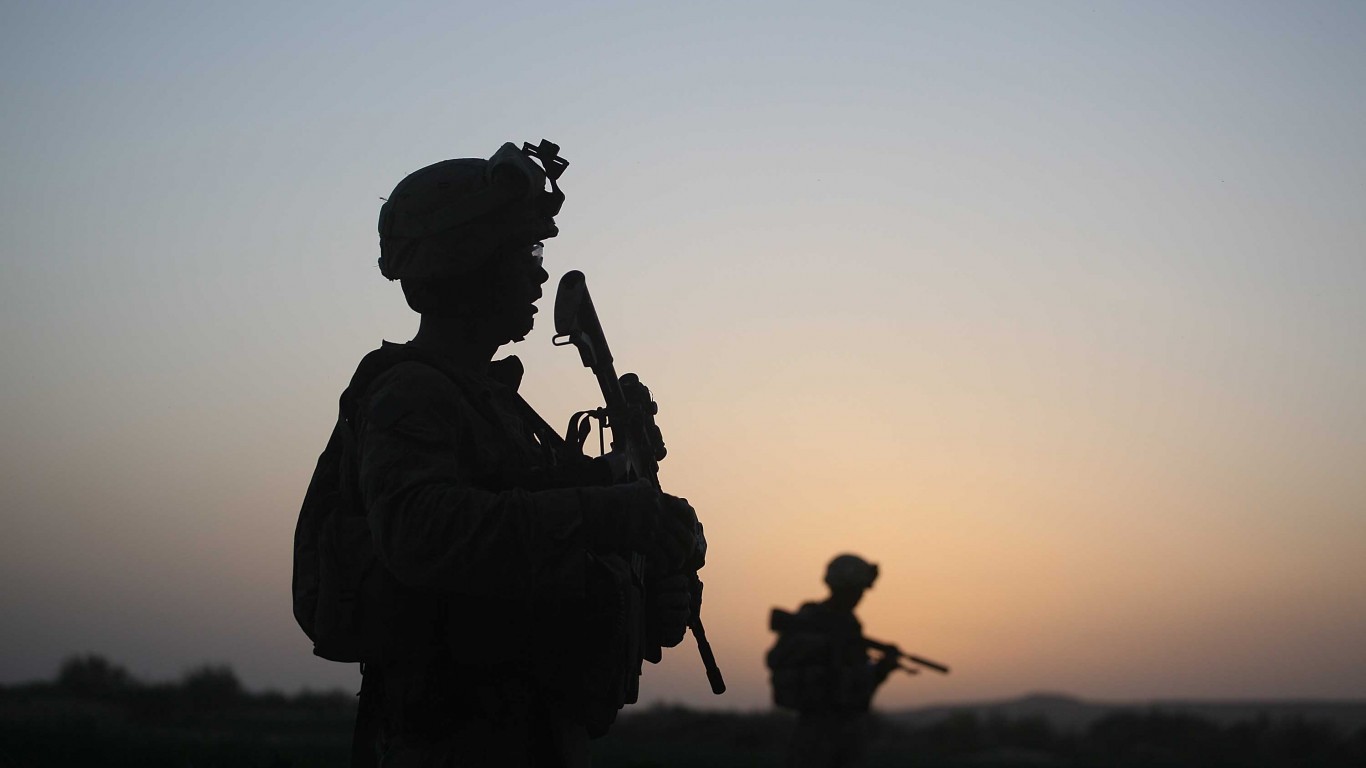
3. Afghanistan
> Start of conflict: 2001
> Refugees & asylum seekers: 2,083,126
> Internally displaced people: 3,218,827
> Total displaced: 5,301,953
> Total displaced as percent of pre-war population: 26%
> Returnees: 7,496,684
> Population (2021): 40,099,460
Afghanistan was the center stage of the U.S. global war on terror that erupted after the Sept. 11, 2001, terrorist attacks orchestrated by Osama bin Laden and al-Qaeda terrorists from their mountainous strongholds in Afghanistan near the border with Pakistan. The U.S. officially ended the 20-year war there on Aug. 30, 2021, after the conflict displaced 5.3 million Afghanis, or 26% of the country’s pre-war population.
Biden said last year that there are no members of the U.S. armed forces in Afghanistan, but that it “remains postured to address threats to the United States homeland and United States interests that may arise from inside Afghanistan.”
[in-text-ad]
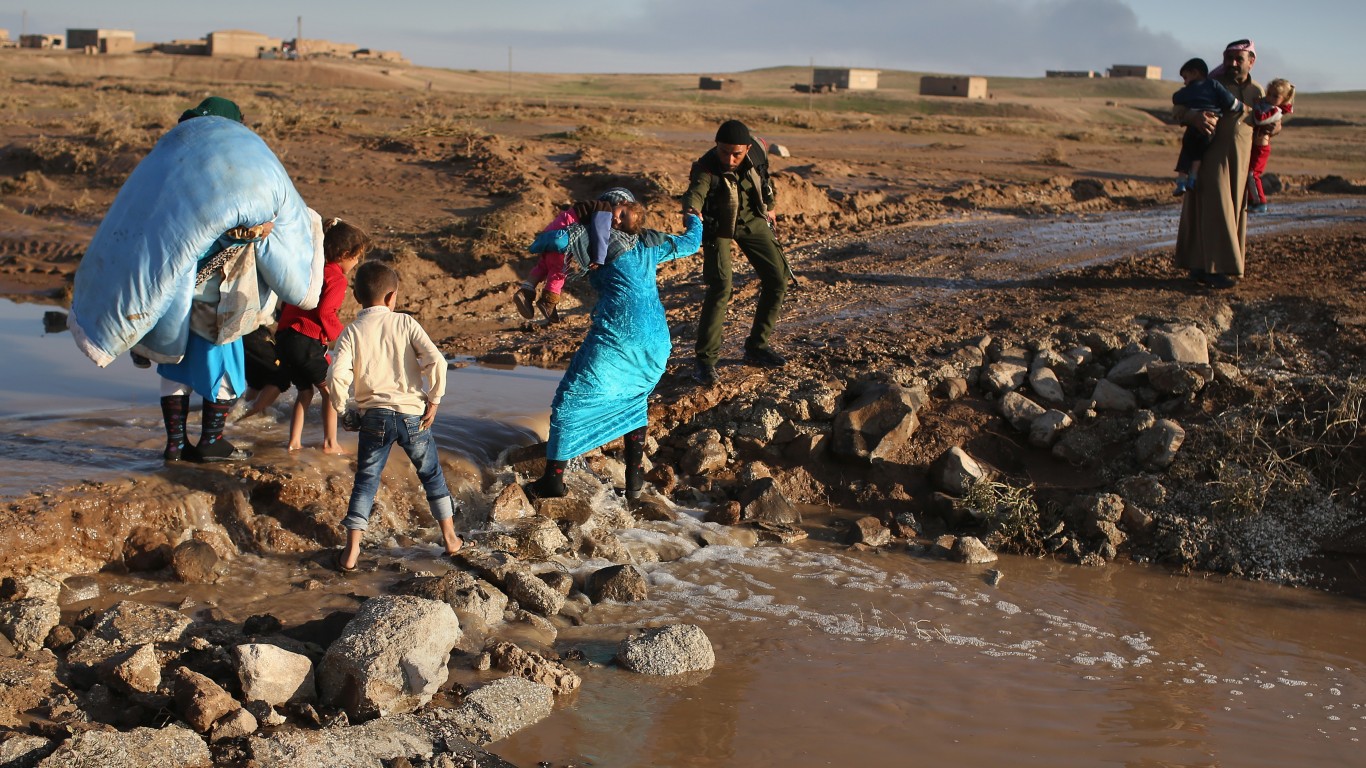
2. Syria
> Start of conflict: 2014
> Refugees & asylum seekers: 2,142,304
> Internally displaced people: 5,004,988
> Total displaced: 7,147,292
> Total displaced as percent of pre-war population: 37%
> Returnees: 1,534,200
> Population (2021): 21,324,370
The United States has been involved in the ongoing Syrian civil war since it initiated in June 2014 Operation Inherent Resolve – a U.S.-led coalition to support Syrian Democratic Forces and other rebel groups against Islamic State group and al-Nusra Front insurgents. Over 7 million Syrians have been displaced as a result of the civil war, or about 37% of the pre-war population.
U.S involvement in Syria is complicated by the fact Russia supports Syrian President Bashar al-Assad forces. Al-assad, in turn, supports Russia’s war in Ukraine. The rebels the U.S. backs are part of Syria’s opposition to al-Assad, and that many are members of the Syrian branch of the PKK, the Kurdish militant and political group considered a terrorist organization by NATO-member Turkey.

1. Iraq
> Start of conflict: 2003
> Refugees & asylum seekers: 2,249,037
> Internally displaced people: 6,963,138
> Total displaced: 9,212,175
> Total displaced as percent of pre-war population: 37%
> Returnees: 6,482,433
> Population (2021): 43,533,590
Critics of the U.S. military expansion of its war on terror to Iraq in 2003 say the justification by President George W. Bush and his supporters was based on false claims, including that the late Iraqi strongman supported Islamic extremists that were in fact his sworn enemies. Regardless, over 9.2 million people have been displaced as a result of the war, 2.2 of which have refugee or asylum seeker status.
Today, the U.S. considers its military engagements in Iraq and Syria to be a unified fight against Islamist extremist activities. In a letter to Congress last year, Biden said U.S. Armed Forces “continue to advise, assist, and enable select elements of the Iraqi security forces” and that the U.S. also provides “limited” support to the NATO mission in Iraq.
The Average American Is Losing Momentum On Their Savings Every Day (Sponsor)
If you’re like many Americans and keep your money ‘safe’ in a checking or savings account, think again. The average yield on a savings account is a paltry .4%1 today. Checking accounts are even worse.
But there is good news. To win qualified customers, some accounts are paying more than 7x the national average. That’s an incredible way to keep your money safe and earn more at the same time. Our top pick for high yield savings accounts includes other benefits as well. You can earn a $200 bonus and up to 7X the national average with qualifying deposits. Terms apply. Member, FDIC.
Click here to see how much more you could be earning on your savings today. It takes just a few minutes to open an account to make your money work for you.
Thank you for reading! Have some feedback for us?
Contact the 24/7 Wall St. editorial team.

